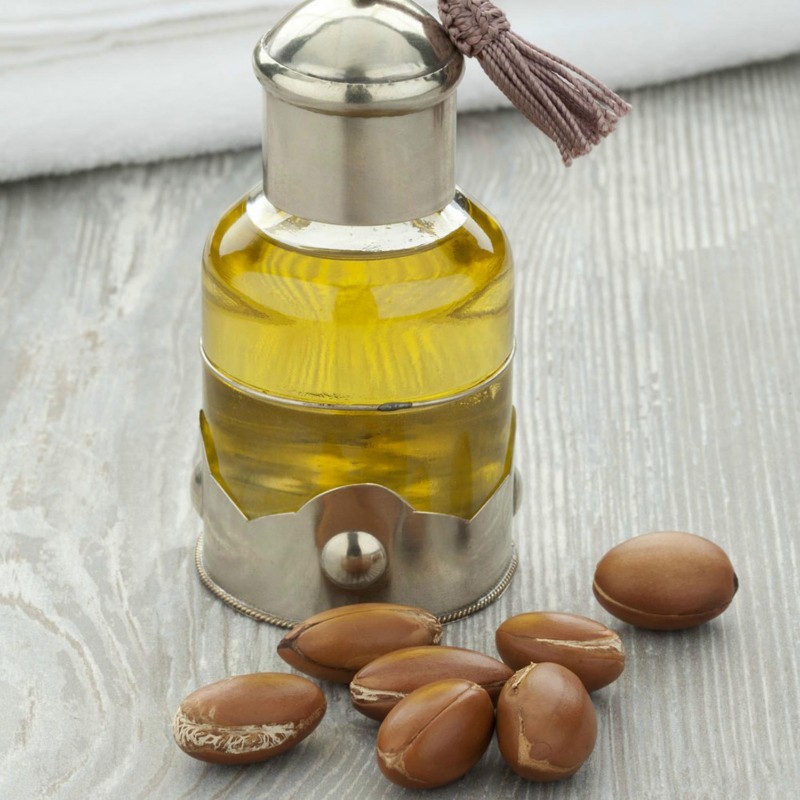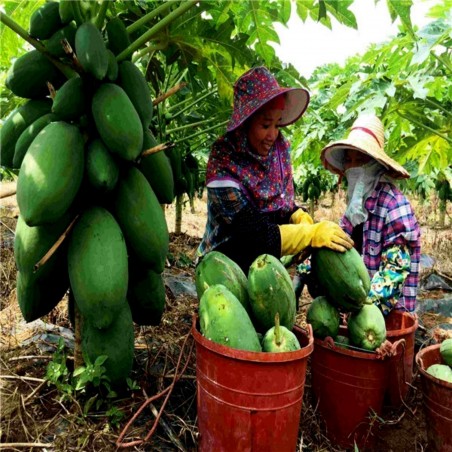
Argan seeds (Argania spinosa)
Argan seeds (Argania Spinosa)
Price for Package of 3 seeds.
Argania (Berber: ⴰⵔⴳⴰⵏ Argan) is a genus of flowering plants containing the sole species Argania Spinosa, known as argan, a tree endemic to the calcareous semidesert Sous valley of southwestern
Argan seeds (Argania Spinosa)
Price for Package of 3 seeds.
Argania (Berber: ⴰⵔⴳⴰⵏ Argan) is a genus of flowering plants containing the sole species Argania Spinosa, known as argan, a tree endemic to the calcareous semidesert Sous valley of southwestern Morocco. Argan trees grow to 8–10 m (26–33 ft) high and live up to approximately 200 years. They are thorny, with gnarled trunks and wide spreading crown. The crown has a circumference of about 70 m (230 ft) and the branches lean towards the ground.
The leaves are small, 2–4 cm (0.79–1.57 in) long, and oval with a rounded apex. The flowers are small, with five pale yellow-green petals; flowering is in April. The fruit is 2–4 cm (0.79–1.57 in) long and 1.5–3 cm (0.59–1.18 in) broad, with a thick, bitter peel surrounding a sweet-smelling but unpleasantly flavored layer of the pulpy pericarp. This surrounds the very hard nut, which contains one (occasionally two or three) small, oil-rich seeds. The fruit takes over a year to mature, ripening in June to July of the following year.
Name
The scientific name argania is derived from argan, the name of the tree in Tasussit, the Berber language which is spoken by the majority of the people living in the areas where the tree is endemic. Tasussit has a rich vocabulary for the various parts of the fruit, its stages of ripeness, and its harvesting and processing. The oil is also called argan. In medieval Arabic pharmacological sources, the tree is known as harjān, a name which is also derived from Tasussit argan.
Cultivation
Goats climbing an Argan tree
In Morocco, arganeraie forests now cover some 8,280 km2 (3,200 sq mi) and are designated as a UNESCO biosphere reserve. Their area has shrunk by about half during the last 100 years, due to charcoal-making, grazing, and increasingly intensive cultivation. The best hope for the conservation of the trees may lie in the recent development of a thriving export market for argan oil as a high-value product. However, the wealth brought by argan oil export has also created threats to argan trees in the form of increased goat population. Locals use the newfound wealth to buy more goats and the goats stunt the growth of the argan trees by climbing up and eating their leaves and fruit.
Argan is grown in Israel, in the Arabah, and Negev.
Uses
In some parts of Morocco, argan takes the place of the olive as a source of forage, oil, timber, and fuel in Berber society. Especially near Essaouira, the argan tree is frequently climbed by goats.
Fruit
Argan fruit falls in July, when black and dry. Until this happens, goats are kept out of the argan woodlands by wardens. Rights to collect the fruit are controlled by law and village traditions. The leftover nuts are gathered after consumption and spit out by ruminating goats. Seeds spat out by the goats constitute an overlooked mechanism of seed dispersal.
Argan oil
Argan oil is produced by several women's co-operatives in the southwestern parts of Morocco. The most labor-intensive part of oil-extraction is removal of the soft pulp (used to feed animals) and the cracking by hand, between two stones, of the hard nut. The seeds are then removed and gently roasted. This roasting accounts for part of the oil's distinctive, nutty flavor.
The traditional technique for oil extraction is to grind the roasted seeds to paste, with a little water, in a stone rotary quern. The paste is then squeezed by hand to extract the oil. The extracted paste is still oil-rich and is used as animal feed. Oil produced this way can be stored and used for 3–6 months, and will be produced as needed in a family, from a store of the kernels, which will keep for 20 years unopened. Dry-pressing is becoming increasingly important for oil produced for sale, as this method allows for faster extraction, and the oil produced can be used for 12–18 months after extraction.
The oil contains 80% unsaturated fatty acids, is rich in essential fatty acids, and is more resistant to oxidation than olive oil. Argan oil is used for dipping bread, on couscous, salads, and similar uses. A dip for bread known as amlou is made from rgan oil, almonds, and peanuts, sometimes sweetened by honey or sugar. The unroasted oil is traditionally used as a treatment for skin diseases, and has become favoured by European cosmetics manufacturers.
Foliage, flowers and immature fruit
Argania Spinosa
Argan oil is sold in Morocco as a luxury item. The product is of increasing interest to cosmetics companies in Europe. It used to be difficult to buy the oil outside Morocco, but since 2001–2002, it has become a fashionable product in Europe and North America. It is now widely available in specialist shops and occasionally in supermarkets. Its price (US$40–50 for 500 ml) is notable compared to other oils.
Argan oil contains:
- 44% Oleic acid
- 30% Alpha-linolenic acid
- 12% Palmitic acid
- 6% Stearidonic acid
- 5% Linoleic acid(Conflicts with the table in argan oil)
- 3% Myristic acid
Animal feed
Argan trees are a major source of forage for sheep, goats, camels, and cattle. Fruits and leaves are readily consumed by livestock. The press cake resulting from oil extraction can also be sun-dried and fed to ruminants. Bees can nest in argan trees, making them sites for wild honey harvesting.
| HEIRLOOM ? | Yes |
|---|---|
| Organic Seeds ? | Organic Seeds |
| Edible ? | Edible |
| Perennial ? | Perennial plant : Yes |
| Handgeplukte zaden? | Handgeplukte zaden |
| Medicinal Plant ? | Medicinal Plant: Yes |


Uw beoordelingswaardering kan niet worden verzonden
Rapporteer reactie
Melding verzonden
Uw opmerking kan niet worden verzonden
Schrijf uw recensie
Beoordeling verstuurd
Uw beoordeling kan niet worden verzonden
🌍 Wereldwijde verzending vanuit de EU
Wij versturen wereldwijd vanuit de Europese Unie via aangetekende post met ontvangstbevestiging.
📦 Pakket volgen
Log in op je account en ga naar Bestelhistorie > Details om je track & trace-nummer te vinden.
Wereldwijde tracking: 17Track
Voor nummers zoals RGxxxxxxHR: Posta.hr tracking
🕒 Wacht minimaal 24 uur na verzending voordat trackinginformatie beschikbaar is.
⚠️ Belangrijke informatie
Betalen bij aflevering is niet mogelijk.
Controleer regelmatig je spam- of ongewenste mailfolder voor belangrijke e-mails.
Gebruik uitsluitend het contactformulier op onze website.
Directe e-mails worden mogelijk niet beantwoord.
📱 Telefoonnummer verplicht
Vermeld bij je bestelling altijd je mobiele telefoonnummer inclusief landcode.
Voorbeeld: +31 6 12345678
🚚 Leveringsvoorwaarden
Aangetekende zendingen vereisen een handtekening van de ontvanger.
Bestel niet als:
Je pakket in een brievenbus geleverd moet worden
Je niet thuis bent om het pakket in ontvangst te nemen
Je wilt dat het pakket bij de buurman wordt bezorgd (❌ niet mogelijk)
📬 Als je een brievenbusadres opgeeft en het pakket kwijt raakt, heb je geen recht op terugbetaling.
↩️ Retourzending en opnieuw verzenden
Als een pakket om welke reden dan ook wordt geretourneerd:
Ben je verantwoordelijk voor retourkosten van €2
En de verzendkosten voor het opnieuw verzenden
⏱ Vertragingen en tracking
Als de tracking aangeeft dat het pakket nog bij de verzender is, betekent dit dat het pakket onderweg is.
Neem contact op met je lokale postkantoor met het trackingnummer voor de meest actuele info.
Wij zijn geen postbedrijf en kunnen het pakket niet voor je volgen.
Wij zijn niet verantwoordelijk voor de levertijd.
🔍 Een onderzoek naar verloren pakketten kan pas gestart worden 30 dagen na verzenddatum.
✈️ Verzendopties
| Verzendmethode | Verwerkingstijd | Verzekering | Mogelijke vertraging | Opmerking |
|---|---|---|---|---|
| Standaard | 7–10 werkdagen | ❌ | 7–14 werkdagen | Goedkoopste optie |
| Prioriteit | 1–7 werkdagen | ❌ | 3–10 werkdagen | Prioriteit in verwerking, niet gegarandeerd sneller |
| Verzekerd | 1–7 werkdagen | ✅ | 3–10 werkdagen | Geld terug bij verlies (tot €150) |
🕒 Geschatte levertijd:
Binnen de EU: 3–20 werkdagen
Wereldwijd: 5–30 werkdagen
Voorbeelden levertijden VS: 27, 22, 19, 17, 13 dagen
💳 Betaalmethoden
💶 Bankoverschrijving (SEPA / IBAN / SWIFT-BIC)
Vermeld altijd je bestelnummer in de omschrijving (bijv. SGS-19811702).
Bij het ontbreken van deze referentie kan je bestelling vertraagd worden of geannuleerd.
Bestellingen die niet binnen 7 dagen betaald zijn, worden automatisch geannuleerd.
🅿️ PayPal
We accepteren alleen betalingen in euro’s via PayPal.
Kies tijdens het betaalproces voor de valuta euro.
💳 Betaling met kaart
Betaling verloopt via onze website: Exotic Seeds Store
We accepteren Visa, MasterCard, American Express, Diners Club, UnionPay, JCB, Discover en meer.
💡 De klant draagt eventuele transactiekosten.
Stuur bij voorkeur een betaalbewijs mee voor een snellere verwerking.
📅 Overige informatie
Wij verwerken en versturen geen bestellingen in het weekend (zaterdag en zondag).
Controleer altijd de belangrijke mededelingen op onze website (feestdagen, speciale voorwaarden e.d.).
📫 Let op:
Stuur geen e-mails rechtstreeks naar ons. Gebruik alleen het contactformulier op onze website voor vragen.
Related Products















